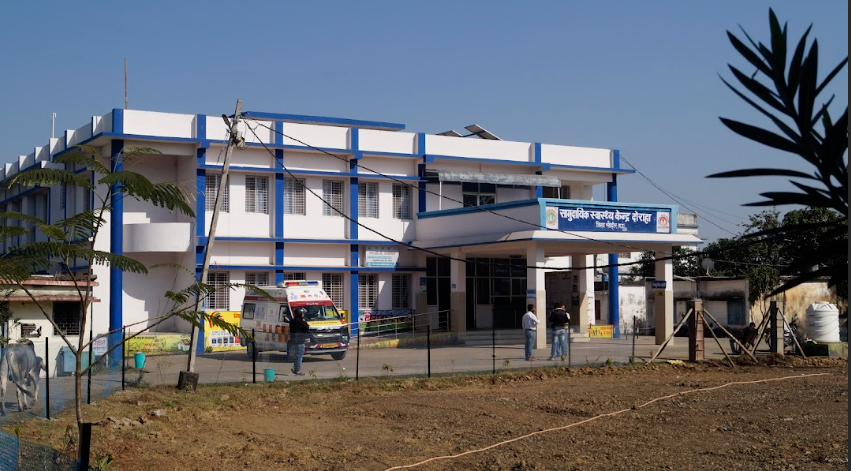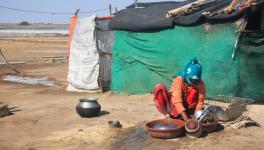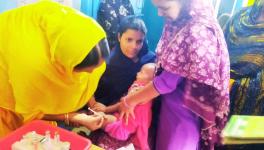Madhya Pradesh: Flaws in Biomedical Waste Management in Rural Areas -- I

At 10 a.m., work continues as a routine at the community health centre of Doraha village in Sehore district of Madhya Pradesh. Patients in the OPD (outpatient department) get their receipts, while healthcare workers and doctors attend to the patients in different wards. This health centre was shifted to a new building only two years ago, and is visibly clean, at a glance.
The hospital in charge explains their biomedical waste management facility, next to the main hospital building. The different coloured dustbins, as per government rules, are kept safely in the storage facility. This waste is collected and taken by vehicle to the Common Bio-Medical Waste Treatment and Disposal Facility (CBWTF). However, in the abandoned room of the old hospital building, glucose bottles, injections, syringes, drip pipes, and blood packets lie as if they are invisible. The hospital in charge said,
“The [biomedical waste collection] vehicle from Sehore does not collect this waste even after insistence… We have to give it to the sweepers.”

However, the waste collection agency holds a markedly different view on this matter, which we'll explore later. First, let's do a deep dive into biomedical waste, and why is its disposal so important.
Biomedical Waste and its Proper Disposal
According to the World Health Organisation (WHO), any waste generated during the treatment or vaccination of humans or animals, in research activities, or in the production or testing of biological substances is called biomedical waste. This includes human and animal bodily waste, and treatment equipment such as needles, syringes, and other materials. The scientific disposal of biomedical waste can reduce the adverse effects on the health and environment of health workers, sanitation workers, and common people related to it.
The Bio-Medical Waste Management (BMWM) Rules, 2016 is India's major notification providing a guide to managing biomedical waste. According to this, all health centres must create a safe and ventilated space within the premises to store segregated biomedical waste in coloured bags or containers. This is primarily to ensure that no one comes in contact with it. In addition, there is no theft of recyclable items, and there is no scattering of the waste by animals or inadvertently on the premises. Eventually, to ensure that the CBWTF can easily collect the waste for disposal. The weight of the waste in each colour bin is recorded on a yellow sheet.

As per the rules, hospitals can also set up their waste treatment system. However, if a CBWTF is present within a radius of 75 km, then they are obliged to send their waste to the facility.
At present, a total of 18 authorised CBWTFs cover the 52 districts of Madhya Pradesh. The state’s total biomedical waste generation is 15.64 tonnes/day, while the current total treatment capacity is 62 tonnes/day, i.e., 4.0 times the total waste generation. Despite this, as of 2022, there are at least 2,671 healthcare centres in the state from which CBWTF doesn’t collect biomedical waste.
Reportedly, there are several irregularities even in the health centres where the collection is happening ‘effectively.’
Doraha Village of Sehore District
About 40 km from the city of Sehore, Doraha village—with a population of 7,624— medical waste from the 30-bed health centre is collected by the Environment Protection Corporation (EPC) in Sehore City. Akhilesh, in charge of the Doraha Community Health Centre, said, “The EPC vehicle comes every alternate day." However, when we visited, the vehicle had not come for the past two days.

On further inquiry, there was another interesting trend. The yellow sheet with the waste collection record had all the categories written in round figures for alternate days. Furthermore, the figures were almost identical. For example, the entry in the white colour code—needles, scalpels, blades, needle tip cutters, or metals like needles—was zero for the entire month.
Apart from this, Akhilesh sais, “CBWTF people refuse to take plastic waste from the red bin." He said the waste was eventually given to the sweepers. However, there was also a regular entry in its column. But, how?
Delay and Reasons for Low Collection of Plastic, Metal Waste
There were three things common during the investigation conducted in different health centres in Sehore district. First, delay in the garbage collection by CBWTF. Second, the column of white colour-coded sharp waste was empty. And third, irregularities in the collection of plastic waste.

According to the rules, it is necessary to collect and dispose of medical waste within 48 hours. Due to delays in collection, the hazardous waste is often left in the open, with the potential for infection.
According to the Gap Analysis Report 2023, released by the Madhya Pradesh Pollution Control Board (MPPCB), there are many such CBWTFs in the state that cover more than one district and collect garbage from a distance of more than 150 km. For example, the Sehore-based CBWTF—Environment Protection Corporation (EPC)—is also responsible for collecting biomedical waste from the Harda, Hoshangabad, Vidisha, and Betul districts. The distance between Betul and Sehore is more than 200 km. In such a situation, a slight lack of coordination can cause delay.
In rural areas with bad road connectivity, delays are more common. To deal with this, the MPPCB suggests garbage collection with the help of two-wheelers or small electric vehicles. However, such a facility has not been started in any rural area yet.
Chandan Khanna, India Project Manager of Health Care Without Harm, says, “The column of white colour-coded metallic sharp waste can't remain empty for a month… Sharps and needles are the most common waste in any bedded health care facility, and they are the most common in spreading infection. In such a situation, not collecting sharps for a month in these hospitals does not indicate well.”

Theft of Infectious Plastic Waste
Imtiaz Beg, manager of CBWTF Sehore EPC, said the plastic waste – colour-coded red—reaches the facility the least. The colour-coded red includes recyclable waste like injections, bottles, drip pipes, etc. This waste is easily sold in the market, and, according to Beg, “it is the hospital staff who are involved in this [illegal] sale.”
Sehore District Hospital employee Sanjulata Bhargav said, “On several occasions, hospital sweepers have been caught with plastic waste. We have taken action, as this [improper disposal of biomedical waste] can have serious health consequences.”
The waste from red-coloured dustbins, mostly recyclable, is treated through autoclaving technology. An autoclave is a machine that uses pressurised steam to kill harmful bacteria, viruses, fungi, and spores on objects kept inside a pressure vessel. Sterilisation happens before recycling to ensure the risk of infections to other individuals managing the waste can be minimised. In the case of theft, the health risk increases significantly.
In the Mandi area of Sehore, a scrap dealer can be seen filling plastic bottles in a sack. We ask him if we can sell hospital waste to him. To this, he, nonchalantly, says, “Yes, we get glucose bottles, injections, pipes, gloves, etc. They buy this waste for Rs 8 per kilo.” On asking about what precautions they take before handling such hospital waste, he laughs, “They don't.”
Brajesh Sharma, Regional Officer, MPPCB, said, “It is in our knowledge that plastic waste reaches in small quantities from the treatment facilities from hospitals. However, either the hospital or the treatment facility has to complain for us to take action.”
He said, “Not just in villages but also in cities, plastic biomedical waste is bought and sold in large quantities. Private clinics and hospitals commit the most irregularities. If the media publishes these reports with evidence, then the Pollution Control Board can take action.”
In India, measures like barcoded bags and GPS-equipped vehicles are in place to prevent theft of biomedical waste. Despite these measures, infectious waste reaches the market. The health centres are not connected to the waste collection facility.
Health Centres and Biomedical Waste Collection
According to the report of the Sehore District Collector's Office, the number of health centres with beds, including government and private, in the district is 60, and without beds is 69. Furthermore, Sehore’s CBWTF EPC collects biomedical waste from just 54 bedded, 56 non-bedded health centres, and 23 pathology centres. According to the report of the Sehore District Collector's Office, health centres located in remote places in rural areas are disposing of their waste only through deep burial methods.
In the case of government health centres in the district, out of the total 25 public health centres, waste collection is done from only 13. Interestingly, the 12 health centres with no waste collection access, are centres in rural areas.
Deep Burial Method Still in Use
After the community health centre of Doraha village, we reach the primary health centre in Ahmedpur village, some 4 km away. However, the EPC vehicle does not collect waste from this centre. On the issue of biomedical waste, the supervisor, Dr. KC Mohaniya, said, "The situation here is very bad".
All the waste is disposed of in a pit behind the health centre and later burned. Yellow category waste, including placenta and human anatomical remains, is disposed of through deep burial methods. According to WHO, burning health care waste in the open can, in some circumstances, lead to emission of dioxins, furans, and particulate matter, which, needless to say, is extremely harmful to health.
Mohaniya said, “During the rainy season, the pits get flooded and the hazardous waste flows into the fields… We have asked the municipality several times, but forget about biomedical waste; even the municipal vehicle that collects wet and dry waste does not come here.”

He mentions that there is an increased inflow of patients in the centre’s OPD. Inevitably, there is an increase in the biomedical waste as well. In such a case, he appeals to the administration to ensure a proper disposal of the waste. On the other hand, Brajesh Sharma of MPPCB is surprised to know that despite road connectivity, the collection vehicle is not reaching Ahmedpur. He said, “We will investigate this matter soon.”
In the Gap Analysis Report 2023, the MPPCB had directed strengthening the collection and transportation of biomedical waste and bring it under the purview of CBWTF to eliminate the deep burial method in remote rural areas. The main objective is to curb groundwater pollution and health-related problems in the surrounding areas. However, in several healthcare centres that we visited, the deep burial method continues.

Other Clinics and Medical Waste From Homes
In a private one-room clinic in Jharkheda village near Doraha, there is a long queue of patients. There is a bed inside on which a patient is lying, with a drip. The doctor checks the pulse of the other patient sitting on a chair and writes the prescription. Besides the doctor, there is a carton with a pile of waste of syringes, bottles, glass vials, and plastic packaging filled up to the brim. And, in the morning, the doctor dumps the waste into the municipal waste collection vehicle with general waste.
When asked, he admitted, “We know how dangerous this waste is, but we have no other option, there is no facility here in the village.”
There are many such clinics. Several doctors from cities like Bhopal organise such health camps on weekends. The biomedical waste from these clinics is collected by general solid waste. Interestingly, the MPPCB has a provision of “service on call” for the collection of biomedical waste in non-bed health centres. However, the private practitioners deny any knowledge of such a service.
“Any healthcare facility that is producing biomedical waste must get permission from the PCB. And failure to do so can result in cancellation of the license,” Sharma said.
Apart from makeshift clinics, biomedical waste is also collected from homes and mixed with general waste. Rajesh Kushwaha, who manages solid waste management in Sehore City, said, "There is a box at the back of our vehicle for sanitary pads and medical waste. But it mostly remains empty. The problem is that if people do not segregate wet and dry waste, then how will they segregate medical waste?"
The lack of waste segregation at the source is a big problem in India. In an ideal world, if people segregate medical waste from home, then a general waste collection vehicle can ensure that it reaches the desired CBWTF for proper disposal. But, such a thing is non-existent on the ground.
The Other Problems
During researching for this report, we found that a system has been established from the segregation and collection to the disposal of biomedical waste. However, several flaws persist. Primarily, this system still seems very weak in rural or remote areas. As per experts, the main reason is the lack of monitoring and strict adherence to the rules.
From the perspective of the CBWTF, it is business. In the meeting held between CBWTF and the State Advisory Committee constituted for biomedical waste management on June 16, 2023, the operators said that the system, work from transportation to incineration, is dependent on diesel. Hence, due to ever-increasing diesel prices, their profits are reducing. In addition, due to non-payment, or delayed payment by government institutions, they have economic crutches. As a solution, the CBWTF want the government to change the rates received per bed.
As per the MPPCB report, biomedical waste generation will increase from the current 15.64 tonnes/day to 31 tonnes by 2032. The total installed treatment capacity of CBWTFs (19 existing + 04 proposed) in the state will be 4,000 kg/hour, i.e., 96 tonnes/day, i.e., almost three times the estimated BMW generation by the year 2032.
Apart from the implementation hurdles, there is a need to adopt BMW as a social responsibility. Many experts consider the current system to be more driven by profits and revenue. Even hazardous and toxic waste is considered a commodity, that should be sold in the market for profits. There has been a significant change in the drafting and negotiation of guidelines around biomedical waste after the COVID-19 pandemic. However, the struggle to dispose of waste efficiently continues in the suburban and rural areas of Sehore district.
(to be continued)
The writers are freelance journalists. This two-part article series is supported by the Health Systems Transformation Platform Fellowship—2023–24.
Get the latest reports & analysis with people's perspective on Protests, movements & deep analytical videos, discussions of the current affairs in your Telegram app. Subscribe to NewsClick's Telegram channel & get Real-Time updates on stories, as they get published on our website.
























